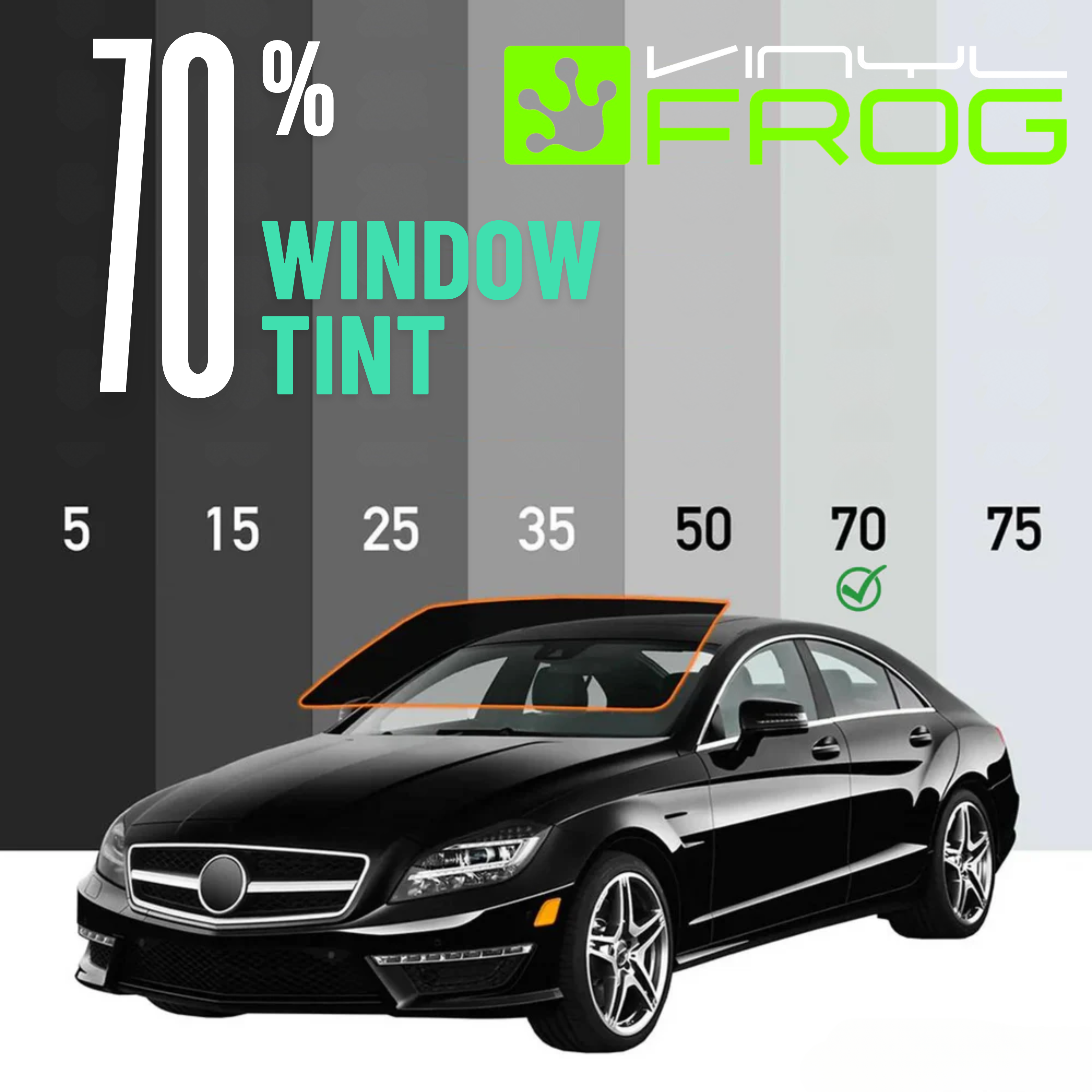Updated By Vinyl Frog On April 22, 2025
How Long Does It Take To Tint Windows?

Tinting windows of your vehicle can be a tedious task. It requires attention to detail and precision, especially if you are doing it yourself and do not have enough practice and expertise. For professional installers, it takes only two to four hours to tint the windows of a vehicle. They can do it easily and thoroughly in less than half a day. A little more time might be required if an old tint has to be removed first.
If you are planning to tint the windows of your car and worried about how long it might take, this is the blog for you. Let’s see how the window tints are applied, what factors affect the duration of the process and how long it takes to install them when you have hired the experts and when you plan to do it yourself.
How Long Does It Take To Apply The Tint?
The time it takes to install a premium quality window tint varies from vehicle to vehicle. The fewer the windows, the lesser the time needed. Window tinting can take up to 2 to 4 hours depending on the size of your car. Commonly, a full-size van or truck will take around 2 to 3 hours to get the windows tinted.
This process requires patience. One has to maintain accuracy and perfection. Tinting windows hastily can lead to an uneven film application that can significantly impair your visibility while driving, especially during nighttime or in low-light conditions. It can also lead to bubbling, creasing, or peeling of the tint. Bubbles can obstruct your view and make the tint appear unsightly, while peeling may require the tint to be redone or removed entirely.

If your car has rear window defrosting elements, improper tint installation can damage or disrupt the functionality of these elements. For example, if the tint film is not cut precisely around the defrosting lines, it may prevent them from functioning correctly, potentially causing visibility issues during cold weather.
To avoid these problems, it is best to have window tinting performed by a professional who has the necessary knowhow, tools, and time to ensure proper installation. They will also be familiar with local regulations, use quality materials, and follow the appropriate techniques to achieve a satisfactory and legal result.
Factors That Affect How Long It Takes to Tint Windows
The time required for car window tinting can vary depending on several elements. Here’s what might delay the process:
Number of Windows
The more windows you want to tint, the longer the process will generally take. Tinting all the windows in your car will naturally require more time compared to tinting just a couple of windows.
Some people only get the rear windows and rear windshield tinted as in most of the states, there is leniency in the VLT percentage of their window tint provided you have the two side mirrors in the front that facilitate the visibility of the road for the driver. This might not take long.
However, if you are getting a tint above the AS-1 line of the front windshield and the front windows on the left and right of the driver as well, it will be time consuming.
Complexity of the Window Design
The complexity of a car's window design can have an impact on the difficulty and time required for window tinting. Cars with curved or angled windows, such as sports cars or vehicles with unique window shapes, can be more challenging to tint compared to windows with straight edges.
The curvature of the windows requires the tint film to be carefully cut and shaped to fit the contours accurately. Achieving a smooth and seamless appearance on curved windows may take more time and precision.
Some cars have windows divided into multiple sections, such as quarter windows or triangular-shaped windows. Tinting these segmented windows can take more time as each section needs to be measured, cut, and tinted separately. The installer must ensure that the film is seamlessly applied to each section and aligns correctly with the adjacent sections.
Experience and Skill of the Installer
The expertise and experience of the installer can significantly impact the time required for window tinting. A skilled professional who has experience working with various vehicle models and window types, and has a good understanding of the techniques and steps involved will generally complete the job more efficiently than an inexperienced or less skilled installer.
Measuring and cutting the tint film according to the dimensions of the windows are time taking tasks. Professionals are well-versed in this, significantly reducing the time spent on re-cutting or adjusting the film to fit correctly. They have likely worked on different car models and window designs, allowing them to efficiently handle various sizes and shapes.
They also have a keen eye for ensuring that the tint film is applied evenly and aligns perfectly with the edges of the windows. They have the necessary skills to manipulate and position the film correctly on the glass surface, minimizing the need for reapplication or adjustments. They also efficiently face the challenges that might arise when tinting windows without taking long.
Preparation Time
Properly preparing the windows before applying the tint film is crucial for a successful installation. This includes cleaning the windows thoroughly and removing any debris or residue. The time taken for preparation can depend on the condition of the windows and the thoroughness of the cleaning process.

Taking off an old film before installing the new one and cleaning the windows after it would take longer. If the film left adhesive residue behind, it will be difficult to clean the window. This is a crucial step that one cannot ignore. The perfect adherence and longevity of the new film depends on how well the windows have been cleaned and prepared hence one cannot rush this step.
Drying and Curing Time
After the tint film is applied, it needs time to dry and cure properly. The specific drying and curing time can vary depending on the type of tint film used and the environmental conditions. The installer will typically provide guidelines on how long to wait before rolling down the windows or exposing them to moisture.
As a general rule, windows that have been tinted freshly should be kept up for at least 48 hours. It is better to keep them rolled up for 72 hours (3 days) to allow maximum curing time and avoid peeling edges. It is ideal to park your car in a shaded area, such as a garage or under a carport during the curing process.
It's essential to keep the car away from extreme temperatures during the curing process. Excessive heat or cold can affect the curing process and potentially lead to issues with the tint film. Avoid parking the car in direct sunlight on hot days or in extremely cold conditions. You cannot even take the car for a drive with the windows rolled up as this will expose the tint to dust and other contaminants.
Additional Features
If your car has additional features like rear window defrosting elements or rain sensors, extra care may be required during the tinting process. This can add some time to the overall installation.
Cars equipped with rear window defrosting elements have thin lines or grids on the glass. These elements aid in defrosting the rear window during cold weather. Tinting these windows requires extra care to cut the tint film around the defrosting lines without damaging or interfering with their functionality. Precise cutting and alignment are necessary which can make the process of window tinting longer.
It's important to note that while there may be factors that can affect the time of car window tinting, it is generally recommended not to rush the process. Proper installation is crucial for achieving the desired results and avoiding potential issues in the future.
The Effect of Seasons on the Duration of Window Tinting Process
The season in which the windows of your vehicle are tinted can also have a bearing on how long the process takes. Let’s see the difference in time during summer and winter.

Window Tinting in Summer
In general, higher temperatures and increased sunlight during the summer season can accelerate the drying time of the tint film. This can be beneficial as it shortens the overall curing period, allowing you to use your windows sooner. However, it's important to note that the tint installer may still provide specific guidelines for the optimal curing time, taking into account the specific tint film and environmental conditions.
While the accelerated drying time can be advantageous, excessive heat and direct sunlight can also pose challenges during the tinting process. It's crucial to protect the freshly applied tint film from prolonged exposure to intense sunlight, as it can cause the film to overheat, bubble, or improperly adhere to the windows. Installers often recommend keeping the car in a shaded area or indoors during the curing process to minimize the impact of direct sunlight.
If summer months in your state also bring higher humidity levels, this can hinder proper adhesion and curing of the tint film making the process longer. Professional installers are skilled in managing humidity during the installation process and may employ techniques to mitigate its impact.
Window Tinting in Winter
Winter is not an ideal month for tinting windows and might make the process long. Cold temperatures can slow down the drying and curing process of the tint film. The adhesive used to attach the film to the windows may take longer to set and bond properly. Also, winter days tend to be shorter, which means there is less daylight available for the tinting process. Sufficient lighting is essential during installation to ensure precise cutting and proper alignment of the tint film.
Furthermore, winter weather conditions such as snow, rain, or excessive moisture can impact the duration of the tinting process. These conditions can make it difficult to properly clean and prepare the windows before tint application making it more time consuming.
The Process of Tinting Windows
Window tinting is a time taking process. We recommend you get it done by professionals to save time and money. However if you want to take the DIY route, you should be prepared to be meticulous.
The first and foremost step is to choose the tint you want for your car. There are different types of window tints available on the market like metallic, dyed, carbon, and ceramic tints. Every tint has its benefits and specialties. The best of all is the ceramic tint but it's expensive. Carbon tint is also highly beneficial but less expensive than ceramic tint.
Clean the windows of your car thoroughly before tinting. Your car may have dust, dirt, or debris on it that will hinder perfect adhesion. Tinting windows may sound like an easy process but it includes important steps that have to be taken with precision. These include measuring and cutting tint according to the size of the windows, cleaning, and application.
What to Avoid When the Tint is Curing to Speed Up the Process?
Once the tint has been applied it takes time to cure. Usually, a tint takes 3 to 4 days to settle and adhere properly to the windows of your vehicle. Here’s what you should avoid when the tint is curing:
- It is generally recommended to keep the windows rolled up. Rolling down the windows prematurely can disrupt the adhesion of the film and may cause it to peel, bubble, or crease.
- Avoid cleaning the newly tinted windows during the curing process. Cleaning solutions, chemicals, or rough materials can potentially damage the tint film or interfere with its adhesion.
- Refrain from touching or applying pressure to the tinted windows while they are curing.
- Avoid applying stickers, decals, or any other adhesive materials to the tinted windows during the curing process.
- It's important to protect the tinted windows from excessive moisture. Also avoid exposure to sunlight for a very long period of time.
How Long Do DIY Window Tints Take?
Getting the windows of your car tinted by a professional will take less time than doing it yourself. If you are not experienced, you might take a day to tint windows. If you have decided to do it yourself then we advise you to get the pre-cut films from a tint kit as it will be easier for you to apply them. You will also need a heat gun, squeegee and a lot of time.
Mistakes To Avoid While Applying Window Tints Yourself
If you are planning to tint the windows of the car yourself rather than getting them done by a professional, avoid these common mistakes:
- Do not rush when cleaning the windows before installation. Failing to adequately prepare the windows before applying the tint can result in poor adhesion and a subpar finish.
- Do not opt for cheap or low-quality tint film. It may save you money initially but can lead to disappointing results. Inferior tint films are more prone to peeling, bubbling, discoloration, and a shorter lifespan. Invest in high-quality tint film that is specifically designed for automotive use to ensure durability and long-term satisfaction.
- Precision is crucial when measuring and cutting the tint film. Inaccurate measurements can result in an improper fit, leaving gaps or overlapping edges.
- Proper installation technique plays a significant role in achieving a smooth and professional-looking result. Avoid applying excessive pressure on the film during installation, as it can cause creases or damage. Use a squeegee to press the film onto the glass, starting from the center and working outward to remove any air bubbles or wrinkles.
- Different regions have specific regulations regarding the darkness and visibility of window tint. It's crucial to research and adhere to the tinting laws in your state to avoid fines or legal issues.
- After tinting the windows, allow enough time for the tint film to dry properly before rolling down the windows or cleaning them. Rushing the curing process can lead to improper adhesion and potential damage to the tint.
- If you're unsure about tinting the windows yourself, it's often best to consult a professional tint installer who has the experience, tools, and expertise for a high-quality installation.
How To Check If The Window Tint Has Dried?
The drying and curing time for window tint can vary depending on factors such as the type of tint film used, environmental conditions, and the specific instructions provided by the installer. It is important to allow the tint film sufficient time to dry and cure properly. Typically, it takes anywhere from a few days to a couple of weeks for the tint to fully dry and cure.
Carefully examine the tinted windows for any visible signs of moisture or condensation between the film and the glass. If you notice any fogging or water droplets, it is an indication that the tint has not dried completely. The film should appear smooth, without any bubbles, creases, or hazy areas. It should also be firmly adhered to the glass surface.
If you have any doubts about the curing status of the window tint, it's best to consult the expert installer. They can provide you with specific guidelines based on the type of tint film used and the curing conditions. They may also be able to visually inspect the tint and advise you on its progress.
Remember that patience is key when determining if the tint has dried completely. Rushing to test the film too soon can disrupt the process and potentially damage the tint.
Frequently Asked Questions
Final Words
Tinting windows is a time consuming process but as we said, the fewer the windows the lesser time it takes. There are many benefits that come with tinting your windows like safety, privacy, and UV protection. In most cases, it would take 2 to 4 hours to completely tint the windows of your vehicle. However, depending on the various factors, this time frame can increase or decrease.
For exquisite, premium, high grade tints, visit Vinyl Frog, the one-stop online store where you will find window tints in different VLT percentages. These are durable and long lasting, and the best for your vehicle giving you excellent value for money.















